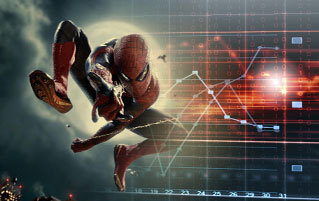4 Absurdly Specific Pop Culture Questions Answered by Fans

I'm a fan of thinking too deeply about fictional characters. That's one of the very few skills anyone at Cracked actually possesses. We're about as qualified to do it as anyone who's watched the same movies and shows over and over until we have to think too deeply about them to find a new way to talk about them. Others are smart enough to think of all that pop culture geekiness in mathematical terms. They quantify the fictional because they can. That's what this article is about -- people who applied numbers, equations, formulas, and ... like charts and shit to better explain and understand the fictional characters we love. They intersected pop culture geekiness and academic nerdiness. They are nerd gods.
How Much Would a Kaiju Pee?

Movies about giant monsters smashing cities and beating the shit out of each other are primarily made for boys to gawk at and wonder how big those monster penises are. Science has not yet answered how big a fake monster's dong would be, but it's found an answer to how much a kaiju would piss. In other words, the scientific community is telling us they're bored and need better things to study.

A deep sea researcher from the U.S. National Evolutionary Synthesis Center who goes by the pen name Dr. M over at Deepseanews.com attempted to mathematically explain the eating and digestive patterns of the kaiju from Pacific Rim. He made a pit stop in their urinary canals along the way.
Everything in an animal's biology scales with size, so he used the equations biologists use to calculate how much food different types of animals need to live and scaled them up to the weights of the kaiju in the movie. It's hard to tell what earthly animals kaiju are most like, so he did the math for the likely candidates -- mammals, birds, reptiles, marine fish, and crustaceans --to cover all the bases.

The good news is that it would take 61.7 years for a single kaiju to eat everyone in Hong Kong. That's bad news for people in Hong Kong, as they are being eaten. Better them than me, I suppose. Those numbers tell us how much kaiju would need to take in, so he calculated how much piss they would pump out, assuming their digestive efficiency wasn't 100 percent. The average kaiju could hose down a city block with the equivalent of 40 barrels of piss. Assuming that it's mammalian, the largest of the kaiju, Slattern, would pee nearly 2,000 gallons a day. If it were more closely related to frogs, Slattern would piss around 1.5 million gallons a day, roughly 92 Olympic-size swimming pools.

Just for shits and giggles, Dr. M crunched the numbers on Godzilla's pee stream, using his 55,000-ton weight from the latest movie. Godzilla would pump out 12,921,400 gallons of radioactive piss a day. Pretty much enough that Godzilla wouldn't need to waste time smashing cities to destroy the Earth. A couple steady streams into our oceans would be enough to turn us all into walking malignant tumors.
How Many Miles Does Mario Run and Swim Trying to Find Princess Peach?

For a middle-aged plumber in overalls, Mario is pretty athletic. The guy has a vertical leap that can make him a top pick in the NBA draft. And he runs and swims like he's training for a triathlon where the third sport is curb stomping. All his running poses an interesting question: In Super Mario Bros., how far does Mario travel before he reaches Princess Peach? Nick Greene over at Mental Floss took the time to figure that out.

The calculation began by trying to find a relative size for everything in the game. Assuming Mario has the body of a normal human whose stance has his feet just a bit wider than his shoulders, he would be 26 inches wide. From there, Nick measured out how many Marios each level would be. If Mario traveled directly to Princess Peach without veering off into warps or bonus areas, the total distance he'd run would be 3.4 miles. Factor in all the bonus levels, and Mario only tacks on another 0.3 miles, bringing his total run distance to 3.7 miles. Then there are the water levels, which total 1,218.5 feet, or as Greene calculated, about 7.5 laps in an Olympic-size swimming pool. With the bonus water levels included, another 344 feet are added on, bringing the total distance Mario travels in water to 1,562.5 feet, a little over a quarter mile.
Mario's epic journey through a magical land filled with villainous mushrooms, man-eating plants, and evil turtle overlords was a grand total of about 3.7 miles long. Now, let's consider that the current speed-run world record for Super Mario Bros. without mods or tricks is 4:53:69. The real-life world record for a mile run is 3:43:13, set by Hicham El Guerrouj in 1999. Mario would absolutely destroy that record back on Earth, but instead he chooses to keep rescuing a princess who by this point clearly wants to be in the cold, scaly, yet loving hands of a giant evil turtle. Mario's priorities are all fucked up.

Another group of people trying to apply math to fictional characters figured out that Mario runs about 20 meters per second, and they discovered that as they attempted to answer a different question surrounding another classic video game character ...
How Fast Can Sonic the Hedgehog Run?

For years we've been told that Sonic runs at the speed of sound. Bullshit. If you compare their speeds in their first games, Mario actually runs faster than Sonic. And Sonic's top speed doesn't even approach the speed of sound. It's all a goddamn lie!
Just as Nick Greene measured Mario levels with Mario himself, the folks at the Game Theory video series measured Sonic's height in the 2006 game Sonic the Hedgehog (3 feet 7 inches) and used it to measure how many Sonics would stretch across Act 1 of Green Hill Zone (the very first Sonic level in the series): 236 Sonics, which is 259.6 meters. According to their research, the world record for completing Act 1 of Green Hill Zone is 25 seconds. At his fastest, Sonic runs 10 meters per second. At sea level, the speed of sound clocks in at 340.29 m/s. Not only does Sonic fail to even approach the sound barrier, but even with his stubby little legs, Mario's pudgy ass is twice as fast as Sonic.

They also discovered that Sonic isn't even as fast as Doctor Robotnik. Whenever he flees from Sonic on foot, Sonic can never keep up. At one point in the first game, Robotnik goes from 0 to 60 in a quarter of a second fleeing from Sonic. Sonic can't even run at the speed of two fat guys. Sonic the Hedgehog is a crock of shit.
Pretty Much Everything You'd Ever Want to Know About Spider-Man's Webs

I proclaim Rhett Allain of Wired's Dot Physics blog the Internet's king of applying math to fiction. Want to know who's faster, the Flash or Quicksilver? Here's your answer. Want to know if Godzilla could ice skate? Here's your answer. Want to know if Superman could punch a person into space if he were so inclined? Here's your answer. This whole article could be made up of his articles alone. But instead, I'm choosing to focus on just one -- one that (quite complexly) answered questions I've had about Spider-Man's webs but have always been far too stupid, lazy, and a third thing to work through mathematically.
Allain began by trying to find out how strong the webs are based on a scene in one of the movies where Spider-Man uses his webs to catch a falling car. Using the momentum principle, he estimated that a falling car with an assumed mass of 2,000 kg with an assumed stopping time of 1 second and a final momentum of 0 would need to be stopped by a web with a tension of 39,200 Newtons. It would have to be thin enough to be fired from a small cylinder, thus ruling out large steel cables. That fits the description of carbon nanotube rope.

Then he tried to figure out how much webbing Spider-Man could carry with him. If Spider-Man's web shooter had the volume of a standard pencil, the pencil would need to be nearly 10.5 feet long for just one shot. Allain bumped the number of shots to 50 and calculated that Spider-Man would need web shooters the size of cinder blocks to contain all that webbing:

The process of finding out how fast the webs fire out of the shooters is long and complicated, and it involves multiple formulas and a program that simulates and charts motion and acceleration. If you're a physics major, read the original article and have a blast. For the rest of us, I'll cut to the chase: The webs would fire at around 54 mph, and a horizontal shot would have a range of 58.5 meters, close to 200 feet. There. Now we can all rest easy knowing that a fake person's wrist splooge travels just under the speed limit of most major highways.
Luis is busy applying math to Smurf sex patterns. In the meantime, drop him a line on Twitter and Tumblr.
